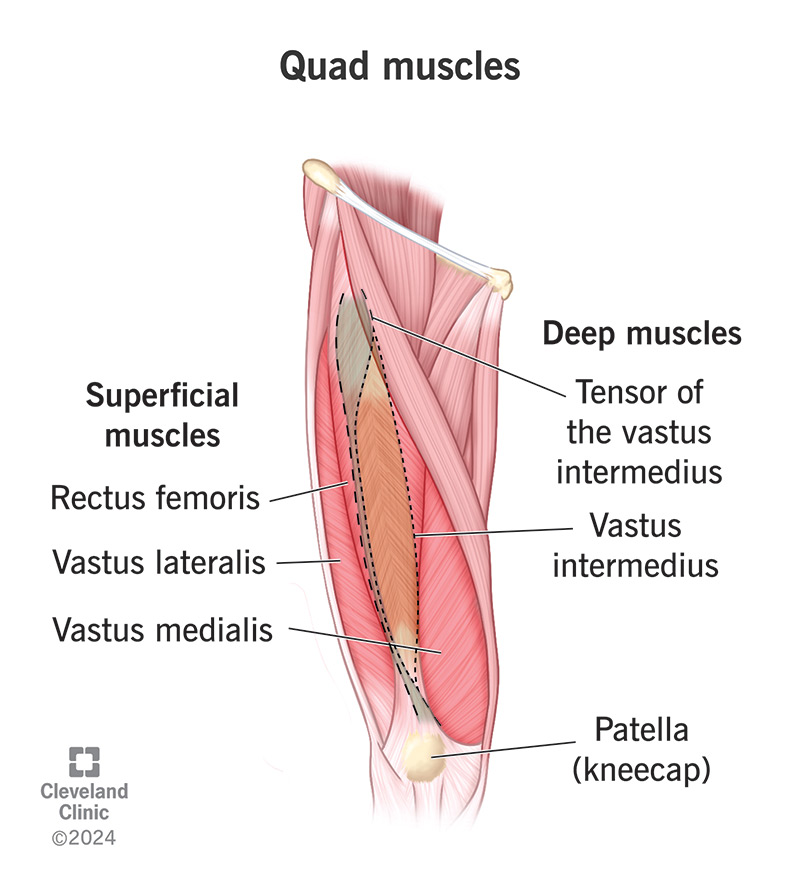Your quad muscles, or quadriceps, are at the front of your thigh. They help you straighten your knee so you can kick, run and jump. But these muscles are prone to injuries like strains, contusions and tendonitis. See your healthcare provider if you have numbness or severe pain, or can’t move your leg.
Advertisement
Cleveland Clinic is a non-profit academic medical center. Advertising on our site helps support our mission. We do not endorse non-Cleveland Clinic products or services. Policy

Your quad muscles, or quadriceps femoris, are a group of leg muscles at the front of your thigh. Together, they contain more mass than any other muscle group in your body. You use these thigh muscles to perform a variety of movements, including kicking, running, jumping and walking. Your quads are voluntary muscles, meaning you control how they move and work.
Advertisement
Cleveland Clinic is a non-profit academic medical center. Advertising on our site helps support our mission. We do not endorse non-Cleveland Clinic products or services. Policy
In the past, experts believed there were four quad muscles. In Latin, the root “quad” means “four or fourth.” But recently, they discovered a fifth muscle in this group.
The main purpose of your quad muscles is to help you straighten your knee. But they also:
Your quad muscles are on the front of your thigh, above your knee and below your hip. Quad tendons attach them to your pelvis, hip bones, femurs (thigh bones) and kneecaps.
The five quad muscles are:
Advertisement
All five of these muscles have heads that merge into a single tendon, the quadriceps femoris tendon. This tendon attaches them to your kneecap.
Your quads contain lots of tiny, elastic muscle fibers. These fibers help your thigh muscles contract, or tighten. The fibers are red and white, giving the muscles a striped appearance.
The most common quadriceps femoris injuries are strains, or “pulled quads.” A strained quad muscle is the result of overstretched muscle fibers. Thigh strains can range from mild — slight overstretching — to severe, meaning your quad tendon completely tears away from your kneecap (quad tendon tear).
Other quad muscle injuries include:
Quadriceps muscle injuries may cause:
Quad muscle injuries are common in athletes who run, jump and kick. This includes sprinters and people who play soccer, football, rugby, basketball and softball.
You’re also at risk for quad muscle injuries if you:
Contact your healthcare provider right away if you:
Your quad muscles play a vital role in helping you walk, run, jump and kick. But these muscles are also very prone to injuries — like muscle strains and contusions — that can prevent you from straightening your knee or bearing weight on your leg. Most mild-to-moderate quad injuries get better with nonsurgical treatments. But a severe injury, like a torn quad tendon, may need surgery.
Advertisement
Take care of your quadriceps and reduce your risk of injury by warming up and stretching before physical activity. You should also rest your quads if you feel pain or fatigue. More importantly, if pain persists in the front of your thigh, seek immediate medical attention.
Advertisement
Cleveland Clinic’s primary care providers offer lifelong medical care. From sinus infections and high blood pressure to preventive screening, we’re here for you.

Last reviewed on 03/23/2025.
Learn more about the Health Library and our editorial process.